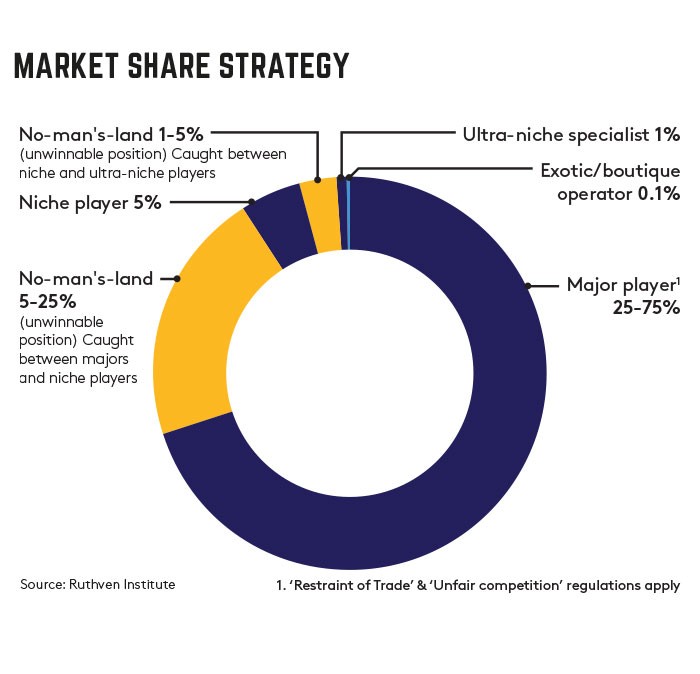Safe and profitable market positioning is the only business end game, writes Phil Ruthven AM.
Successful businesses like to control their own destiny. Many factors enable this to be achieved, including focus, unique intellectual property, leadership and organisational culture (business energy, values and some quirkiness). Another critical factor is market positioning. How does a business get to a place where it can be master of its own destiny without having to constantly look over its shoulder for threatening competitors? Are there actually safe positions? The Ruthven Institute says yes, based on decades of analysis by IBISWorld of the nation’s 2000 largest businesses, which account for nearly half the nation’s $5 trillion-plus revenue.
Safe havens
Four positions offer safety — not impregnability. In essence, it is about dominance in the marketplace, without that being a restriction of competition, having an unfair advantage or being in an illegal situation. Quality and/or uniqueness and price must increase as an operator chooses to come down this order of size:
- Major player (more than 25 per cent of the revenue). Needs to have 35–50 per cent shares of the segments and product groups in which they compete. The strength is economy of scale within purchasing, production, marketing and distribution — with a low-cost product to appeal to mass-market segments — but it’s wise not to try to reach all consumer segments.
- Niche player (five per cent of an industry’s revenue). Needs to dominate one market segment (50 per cent-plus share). Usually product-based, but can be geography-based. The chosen segment is often one of the more upmarket in the overall market. As long as it is clearly definable — in terms of products, customer profile or geographic area — and can lead to dominance of the level suggested, this segment can provide the player the opportunity to be master of their own destiny.
- Ultra-niche specialist (one per cent of an industry’s revenue) dominates a product group within a segment that is less than two per cent of the overall market — but with a 75 per cent-plus share.
- Boutique/exotic operator (0.1 per cent share of the industry’s revenue). “Owns” a product line outright with no competitors. Usually at the most expensive end of the market, often with eye-watering prices.

No-go zones
The following positions should be avoided:
- Monopolistic/near-monopoly operator (75–100 per cent share) — due to the illegality of such market control and/or the dis-economy of scale arising from having to produce all products for the market and losing money on a lot of them, and/or the attraction of a more powerful local or foreign competitor.
- Sub-optimal player (five to 25 per cent share). Insufficient economies of scale to compete with majors, but too little focus, IP and excellence to compete with niche specialists.
- Nomad player (one to five per cent share). Not enough size to compete with ultra-niche specialists, and not enough uniqueness to compete with boutique players.
If you’re in an unsafe position, your first move should be a merger (get bigger) or disaggregation into semi-autonomous niches or ultra-niches. This is more urgent when an industry or market is in the mature part of its lifecycle.
New technology has disrupted markets and while it isn’t changing the positioning rules, it’s worth a mention. For example, online retailing (Amazon, eBay, Alibaba) is often now a third iteration of department stores (after the traditional and discount eras of the past century). They start unprofitably then become ultra-niche, then niche. Online pharmacy retailers are in the discount sector along with Chemist Warehouse and others, competing on price and convenience.
Few businesses achieve world’s best practice returns on equity in Australia because more than half of them are in the wrong position to win and be profitable. The successful ones are.
Latest news
Already a member?
Login to view this content


